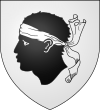Corse-du-Sud facts for kids
Quick facts for kids
Corse-du-Sud
(Southern Corsica) |
||
|---|---|---|
|
||

Location of Corse-du-Sud in France
|
||
| Country | France | |
| Region | Corsica | |
| Former prefecture | Ajaccio | |
| Subprefectures | Sartène | |
| Area | ||
| • Total | 4,014 km2 (1,550 sq mi) | |
| Population
(2013)
|
||
| • Total | 149,234 | |
| • Rank | 96th | |
| • Density | 37.178/km2 (96.292/sq mi) | |
| Time zone | UTC+1 (CET) | |
| • Summer (DST) | UTC+2 (CEST) | |
| Department number | 2A | |
| Arrondissements | 2 | |
| Cantons | 11 | |
| Communes | 124 | |
| French Land Register data, which exclude estuaries, and lakes, ponds, and glaciers larger than 1 km2 | ||
Corse-du-Sud is still as of 2019[update] an administrative department of France consisting of the southern part of the island of Corsica. The corresponding departmental territorial collectivity merged with that of Haute-Corse on 1 January 2018, forming the single territorial collectivity of Corsica, coinciding with territorial elections The people living in Corse-du-Sud are called "Southerners" (Suttanacci).
History
The department was formed on 15 September 1975, when the single department of Corsica was divided into Haute-Corse and Corse-du-Sud. Its boundaries corresponded to the former department of Liamone, which existed from 1793 to 1811.
On 6 February 1998, Corse-du-Sud's prefect Claude Érignac was assassinated in Ajaccio. The Corsican nationalist Yvan Colonna was eventually convicted of the crime.
On 6 July 2003 a referendum rejected increased autonomy by a small majority, with 50.98 percent voting against and 49.02 percent for. This was a major setback for the French Minister of the Interior, Nicolas Sarkozy, who had hoped to use Corsica as the first step in his decentralization programme.
Geography
The department was surrounded on three sides by the Mediterranean Sea and on the north by the department of Haute-Corse. The entire island of Corsica is mountainous with many beautiful beaches.
Tourism
The former department enjoys the mild and hot climate of Mediterranean Islands, and therefore attracts a lot of tourists. Its perhaps largest tourist attraction is the city of Bonifacio, part of which is built upon a huge cliff. But inside mountains are beautiful as well, especially the Aiguilles de Bavella, some needle-like rocks.
Related Pages
Images for kids
See also
 In Spanish: Córcega del Sur para niños
In Spanish: Córcega del Sur para niños








